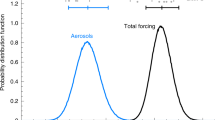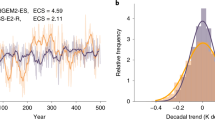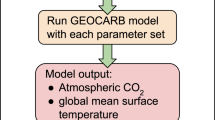Abstract
The Earth's climate is changing rapidly as a result of anthropogenic carbon emissions, and damaging impacts are expected to increase with warming. To prevent these and limit long-term global surface warming to, for example, 2 °C, a level of stabilization or of peak atmospheric CO2 concentrations needs to be set. Climate sensitivity, the global equilibrium surface warming after a doubling of atmospheric CO2 concentration, can help with the translation of atmospheric CO2 levels to warming. Various observations favour a climate sensitivity value of about 3 °C, with a likely range of about 2–4.5 °C. However, the physics of the response and uncertainties in forcing lead to fundamental difficulties in ruling out higher values. The quest to determine climate sensitivity has now been going on for decades, with disturbingly little progress in narrowing the large uncertainty range. However, in the process, fascinating new insights into the climate system and into policy aspects regarding mitigation have been gained. The well-constrained lower limit of climate sensitivity and the transient rate of warming already provide useful information for policy makers. But the upper limit of climate sensitivity will be more difficult to quantify.
This is a preview of subscription content, access via your institution
Access options
Subscribe to this journal
Receive 12 print issues and online access
$259.00 per year
only $21.58 per issue
Buy this article
- Purchase on Springer Link
- Instant access to full article PDF
Prices may be subject to local taxes which are calculated during checkout






Similar content being viewed by others
References
Cox, P. & Stephenson, D. Climate change—A changing climate for prediction. Science 317, 207–208 (2007).
Wigley, T. M. L. & Raper, S. C. B. Interpretation of high projections for global-mean warming. Science 293, 451–454 (2001).
Knutti, R., Stocker, T. F., Joos, F. & Plattner, G.-K. Constraints on radiative forcing and future climate change from observations and climate model ensembles. Nature 416, 719–723 (2002).
Bony, S. et al. How well do we understand and evaluate climate change feedback processes? J. Clim. 19, 3445–3482 (2006).
Randall, D. A. et al. in Climate Change 2007: The Physical Science Basis. Contribution of Working Group I to the Fourth Assessment Report of the Intergovernmental Panel on Climate Change (ed. Solomon, S. et al.) 589–662 (Cambridge Univ. Press, 2007).
Domingues, C. M. et al. Improved estimates of upper-ocean warming and multi-decadal sea-level rise. Nature 453, 1090–U1096 (2008).
Forster, P. et al. in Climate Change 2007: The Physical Science Basis. Contribution of Working Group I to the Fourth Assessment Report of the Intergovernmental Panel on Climate Change (ed. Solomon, S. et al.) 129–234 (Cambridge Univ. Press, 2007).
Roe, G. H. & Baker, M. B. Why is climate sensitivity so unpredictable? Science 318, 629–632 (2007).
Hansen, J. et al. in Climate Processes and Climate Sensitivity (ed. Hansen, J. & Takahashi, T.) Vol. 29 (American Geophysical Union, 1984).
Schlesinger, M. Equilibrium and transient climatic warming induced by increased atmospheric CO2 . Clim. Dyn. 1, 35–51 (1986).
Meehl, G. A. et al. Combinations of natural and anthropogenic forcings in twentieth-century climate. J. Clim. 17, 3721–3727 (2004).
Senior, C. A. & Mitchell, J. F. B. The time-dependence of climate sensitivity. Geophys. Res. Lett. 27, 2685–2688 (2000).
Boer, G. J. & Yu, B. Climate sensitivity and climate state. Clim. Dyn. 21, 167–176 (2003).
Hargreaves, J. C., Abe-Ouchi, A. & Annan, J. D. Linking glacial and future climates through an ensemble of GCM simulations. Clim. Past 3, 77–87 (2007).
Hansen, J. et al. Efficacy of climate forcings. J. Geophys. Res. 110, D18104 (2005).
Tett, S. F. B. et al. The impact of natural and anthropogenic forcings on climate and hydrology since 1550. Clim. Dyn. 28, 3–34 (2007).
Andronova, N., Schlesinger, M. E., Dessai, S., Hulme, M. & Li, B. in Human-induced Climate Change: An Interdisciplinary Assessment (ed. Schlesinger, M. E. et al.) 5–17 (Cambridge Univ. Press, 2007).
Hegerl, G. C. et al. in Climate Change 2007: The Physical Science Basis. Contribution of Working Group I to the Fourth Assessment Report of the Intergovernmental Panel on Climate Change (ed. Solomon, S. et al.) 663–745 (Cambridge Univ. Press, 2007).
National Research Council. Radiative Forcing of Climate Change: Expanding the Concept and Addressing Uncertainties (National Academies Press, 2005).
IPCC (ed.) Climate Change 2001: The Scientific Basis. Contribution of Working Group I to the Third Assessment Report of the Intergovernmental Panel on Climate Change (Cambridge Univ. Press, 2001).
Wigley, T. M. L. & Schlesinger, M. E. Analytical solution for the effect of increasing CO2 on global mean temperature. Nature 315, 649–652 (1985).
Knutti, R., Joos, F., Müller, S. A., Plattner, G.-K. & Stocker, T. F. Probabilistic climate change projections for CO2 stabilization profiles. Geophys. Res. Lett. 32, L20707 (2005).
Allen, M. R. et al. in Avoiding Dangerous Climate Change (ed. Schellnhuber, H. J. et al.) 281–289 (Cambridge Univ. Press, 2006).
Meehl, G. A. et al. in Climate Change 2007: The Physical Science Basis. Contribution of Working Group I to the Fourth Assessment Report of the Intergovernmental Panel on Climate Change (ed. Solomon, S. et al.) 747–845 (Cambridge Univ. Press, 2007).
Arrhenius, S. On the influence of carbonic acid in the air upon the temperature of the ground. Phil. Mag. 41, 237–276 (1896).
Callendar, G. S. The artificial production of carbon dioxide and its influence on temperature. Q. J. R. Meteorol. Soc. 64, 223–240 (1938).
Manabe, S. & Wetherald, R. T. Thermal equilibrium of the atmosphere with a given distribution of relative humidity. J. Atmos. Sci. 50, 241–259 (1967).
Hansen, J. et al. Climate response-times—Dependence on climate sensitivity and ocean mixing. Science 229, 857–859 (1985).
Budyko, M. I. The effect of solar radiation variations on the climate of the Earth. Tellus 21, 611–619 (1969).
Sellers, W. D. A global climatic model based on the energy balance of the Earth–atmosphere system. J. Appl. Meteorol. 8, 392–400 (1969).
North, G. R., Cahalan, R. F. & Coakley, J. A. Energy balance climate models. Rev. Geophys. Space Phys. 19, 91–121 (1981).
Cess, R. D. et al. Interpretation of cloud–climate feedback as produced by 14 atmospheric general-circulation models. Science 245, 513–516 (1989).
Soden, B. J. & Held, I. M. An assessment of climate feedbacks in coupled ocean–atmosphere models. J. Clim. 19, 3354–3360 (2006).
Stainforth, D. A. et al. Uncertainty in predictions of the climate response to rising levels of greenhouse gases. Nature 433, 403–406 (2005).
Murphy, J. M. et al. Quantification of modelling uncertainties in a large ensemble of climate change simulations. Nature 429, 768–772 (2004).
Knutti, R., Meehl, G. A., Allen, M. R. & Stainforth, D. A. Constraining climate sensitivity from the seasonal cycle in surface temperature. J. Clim. 19, 4224–4233 (2006).
Piani, C., Frame, D. J., Stainforth, D. A. & Allen, M. R. Constraints on climate change from a multi thousand member ensemble of simulations. Geophys. Res. Lett. 32, L23825 (2005).
Wigley, T. M. L., Jones, P. D. & Raper, S. C. B. The observed global warming record: What does it tell us? Proc. Natl Acad. Sci. USA 94, 8314–8320 (1997).
Siegenthaler, U. & Oeschger, H. Transient temperature changes due to increasing CO2 using simple models. Ann. Glaciol. 5, 153–159 (1984).
Knutti, R., Stocker, T. F., Joos, F. & Plattner, G.-K. Probabilistic climate change projections using neural networks. Clim. Dyn. 21, 257–272 (2003).
Andronova, N. G. & Schlesinger, M. E. Objective estimation of the probability density function for climate sensitivity. J. Geophys. Res. 106, 22605–22612 (2001).
Frame, D. J. et al. Constraining climate forecasts: The role of prior assumptions. Geophys. Res. Lett. 32, L09702 (2005).
Forest, C. E., Stone, P. H. & Sokolov, A. P. Estimated PDFs of climate system properties including natural and anthropogenic forcings. Geophys. Res. Lett. 33, L01705 (2006).
Forest, C. E., Stone, P. H., Sokolov, A. P., Allen, M. R. & Webster, M. D. Quantifying uncertainties in climate system properties with the use of recent climate observations. Science 295, 113–117 (2002).
Tomassini, L., Reichert, P., Knutti, R., Stocker, T. F. & Borsuk, M. E. Robust Bayesian uncertainty analysis of climate system properties using Markov chain Monte Carlo methods. J. Clim. 20, 1239–1254 (2007).
Harvey, L. D. D. & Kaufmann, R. K. Simultaneously constraining climate sensitivity and aerosol radiative forcing. J. Clim. 15, 2837–2861 (2002).
Tol, R. S. J. & De Vos, A. F. A Bayesian statistical analysis of the enhanced greenhouse effect. Clim. Change 38, 87–112 (1998).
Gregory, J. M., Stouffer, R. J., Raper, S. C. B., Stott, P. A. & Rayner, N. A. An observationally based estimate of the climate sensitivity. J. Clim. 15, 3117–3121 (2002).
Forster, P. M. D. & Gregory, J. M. The climate sensitivity and its components diagnosed from Earth radiation budget data. J. Clim. 19, 39–52 (2006).
Wigley, T. M. L., Ammann, C. M., Santer, B. D. & Raper, S. C. B. Effect of climate sensitivity on the response to volcanic forcing. J. Geophys. Res. 110, D09107 (2005).
Boer, G. J., Stowasser, M. & Hamilton, K. Inferring climate sensitivity from volcanic events. Clim. Dyn. 28, 481–502 (2007).
Yokohata, T. et al. Climate response to volcanic forcing: Validation of climate sensitivity of a coupled atmosphere–ocean general circulation model. Geophys. Res. Lett. 32, L21710 (2005).
Soden, B. J., Wetherald, R. T., Stenchikov, G. L. & Robock, A. Global cooling after the eruption of Mount Pinatubo: A test of climate feedback by water vapor. Science 296, 727–730 (2002).
Lorius, C., Jouzel, J., Raynaud, D., Hansen, J. & LeTreut, H. The ice-core record—climate sensitivity and future greenhouse warming. Nature 347, 139–145 (1990).
Hoffert, M. I. & Covey, C. Deriving global climate sensitivity from palaeoclimate reconstructions. Nature 360, 573–576 (1992).
Covey, C., Sloan, L. C. & Hoffert, M. I. Paleoclimate data constraints on climate sensitivity: The paleocalibration method. Clim. Change 32, 165–184 (1996).
Masson-Delmotte, V. et al. Past and future polar amplification of climate change: climate model intercomparisons and ice-core constraints. Clim. Dyn. 26, 513–529 (2006).
Annan, J. D., Hargreaves, J. C., Ohgaito, R., Abe-Ouchi, A. & Emori, S. Efficiently constraining climate sensitivity with ensembles of paleoclimate simulations. SOLA 1, 181–184 (2005).
Schneider von Deimling, T., Held, H., Ganopolski, A. & Rahmstorf, S. Climate sensitivity estimated from ensemble simulations of glacial climate. Clim. Dyn. 27, 149–163 (2006).
Crucifix, M. Does the Last Glacial Maximum constrain climate sensitivity? Geophys. Res. Lett. 33, L18701, 10.11029/12006GL027137 (2006).
Andronova, N. G., Schlesinger, M. E. & Mann, M. E. Are reconstructed pre-instrumental hemispheric temperatures consistent with instrumental hemispheric temperatures? Geophys. Res. Lett. 31, L12202, 10.11029/12004GL019658 (2004).
Hegerl, G. C., Crowley, T. J., Hyde, W. T. & Frame, D. J. Climate sensitivity constrained by temperature reconstructions over the past seven centuries. Nature 440, 1029–1032 (2006).
Rind, D. et al. The relative importance of solar and anthropogenic forcing of climate change between the Maunder Minimum and the present. J. Clim. 17, 906–929 (2004).
Royer, D. L., Berner, R. A. & Park, J. Climate sensitivity constrained by CO2 concentrations over the past 420 million years. Nature 446, 530–532 (2007).
Barron, E. J., Fawcett, P. J., Peterson, W. H., Pollard, D. & Thompson, S. L. A Simulation of Midcretaceous climate. Paleoceanography 10, 953–962 (1995).
Shaviv, N. J. On climate response to changes in the cosmic ray flux and radiative budget. J. Geophys. Res. 110, A08105, 10.01029/02004JA010866 (2005).
Chylek, P. et al. Limits on climate sensitivity derived from recent satellite and surface observations. J. Geophys. Res. 112, D24S04, 10.1029/2007JD008740 (2007).
Lindzen, R. S. & Giannitsis, C. Reconciling observations of global temperature change. Geophys. Res. Lett. 29, 1583, 10.1029/2001GL014074 (2002).
Schwartz, S. E. Heat capacity, time constant, and sensitivity of Earth's climate system. J. Geophys. Res. 112, D24S05, 10.1029/2007JD008746 (2007).
Douglass, D. H. & Knox, R. S. Climate forcing by the volcanic eruption of Mount Pinatubo. Geophys. Res. Lett. 32, L05710, 10.01029/02004GL022119 (2005).
Chylek, P. & Lohmann, U. Aerosol radiative forcing and climate sensitivity deduced from the last glacial maximum to Holocene transition. Geophys. Res. Lett. 35, L04804, 10.01029/02007GL032759 (2008).
Wigley, T. M. L., Ammann, C. M., Santer, B. D. & Taylor, K. E. Comment on 'Climate forcing by the volcanic eruption of Mount Pinatubo' by David H. Douglass and Robert S. Knox. Geophys. Res. Lett. 32, L20709, 10.1029/2005GL023312 (2005).
Knutti, R., Krähenmann, S., Frame, D. J. & Allen, M. R. Comment on 'Heat capacity, time constant and sensitivity of Earth's climate system' by S. E. Schwartz. J. Geophys. Res. 113, D15103, 10.11029/12007JD009473 (2008).
Foster, G., Annan, J. D., Schmidt, G. A. & Mann, M. E. Comment on 'Heat capacity, time constant, and sensitivity of Earth's climate system' by S. E. Schwartz. J. Geophys. Res. 113, D15102, 10.11029/12007JD009373 (2008).
Edwards, T. L., Crucifix, M. & Harrison, S. P. Using the past to constrain the future: How the paleorecord can improve estimates of global warming. Prog. Phys. Geogr. 31, 481–500 (2007).
Van der Sluijs, J., Van Eijndhoven, J., Shackley, S. & Wynne, B. Anchoring devices in science and policy: The case of consensus around climate sensitivity. Social Stud. Sci. 28, 291–323 (1998).
Reichler, T. & Kim, J. How well do coupled models simulate today's climate? Bull. Am. Meteorol. Soc. 89, 303–311 (2008).
Charney, J. G. Carbon Dioxide and Climate: A Scientific Assessment (National Academy of Science, 1979).
IPCC (ed.) Climate Change 1995: The Science of Climate Change. Contribution of Working Group I to the Second Assessment Report of the Intergovernmental Panel on Climate Change (Cambridge Univ. Press, 1996).
Wigley, T. M. L. & Raper, S. C. B. Natural variability of the climate system and detection of the greenhouse effect. Nature 344, 324–327 (1990).
Frame, D. J., Stone, D. A., Stott, P. A. & Allen, M. R. Alternatives to stabilization scenarios. Geophys. Res. Lett. 33, 10.1029/2006GL025801 (2006).
Joshi, M. et al. A comparison of climate response to different radiative forcings in three general circulation models: Towards an improved metric of climate change. Clim. Dyn. 20, 843–854 (2003).
Davin, E. L., de Noblet-Ducoudre, N. & Friedlingstein, P. Impact of land cover change on surface climate: Relevance of the radiative forcing concept. Geophys. Res. Lett. 34, L13702, 10.11029/12007GL029678 (2007).
Gregory, J. M. et al. A new method for diagnosing radiative forcing and climate sensitivity. Geophys. Res. Lett. 31, L03205, 10.1029/2003GL018747 (2004).
Voss, R. & Mikolajewicz, U. Long-term climate changes due to increased CO2 concentration in the coupled atmosphere–ocean general circulation model ECHAM3/LSG. Clim. Dyn. 17, 45–60 (2001).
Gregory, J. & Webb, M. Tropospheric adjustment induces a cloud component in CO2 forcing. J. Clim. 21, 58–71 (2008).
Andrews, T. & Forster, P. M. CO2 forcing induces semi-direct effects with consequences for climate feedback interpretations. Geophys. Res. Lett. 35, L04802, 10.01029/02007GL032273 (2008).
Hansen, J. et al. Climate change and trace gases. Phil. Trans. R. Soc A 365, 1925–1954 (2007).
Swingedouw, D. et al. Antarctic ice-sheet melting provides negative feedbacks on future climate warming. Geophys. Res. Lett. 35, L17705, 10.11029/12008GL034410 (2008).
Morgan, M. G. & Keith, D. W. Climate change—Subjective judgments by climate experts. Environ. Sci. Technol. 29, A468–A476 (1995).
Annan, J. D. & Hargreaves, J. C. Using multiple observationally-based constraints to estimate climate sensitivity. Geophys. Res. Lett. 33, L06704, 10.1029/2005GL025259 (2006).
Hall, A. & Qu, X. Using the current seasonal cycle to constrain snow albedo feedback in future climate change. Geophys. Res. Lett. 33, L03502, 10.01029/02005GL025127 (2006).
Harvey, L. D. D. Allowable CO2 concentrations under the United Nations Framework Convention on Climate Change as a function of the climate sensitivity probability distribution function. Environ. Res. Lett. 2, 014001, 10.1088/1748-9326/1082/1081/014001 (2007).
Weitzman, M. On modeling and interpreting the economics of catastrophic climate change. Rev. Econ. Stat. (in the press).
Knutti, R. et al. A review of uncertainties in global temperature projections over the twenty-first century. J. Clim. 21, 2651–2663 (2008).
Stott, P. A. et al. Observational constraints on past attributable warming and predictions of future global warming. J. Clim. 19, 3055–3069 (2006).
Knutti, R. & Tomassini, L. Constraints on the transient climate response from observed global temperature and ocean heat uptake. Geophys. Res. Lett. 35, L09701, 10.01029/02007GL032904 (2008).
Stott, P. A. & Forest, C. E. Ensemble climate predictions using climate models and observational constraints. Phil. Trans. R. Soc. A 365, 2029–2052 (2007).
Plattner, G.-K. et al. Long-term climate commitments projected with climate-carbon cycle models. J. Clim. 21, 2721–2751, 10.1175/2007JCLI1905.2721 (2008).
IPCC. in Climate Change 2007: Impacts, Adaptation and Vulnerability. Contribution of Working Group II to the Fourth Assessment Report of the Intergovernmental Panel on Climate Change (ed. Parry, M. L. et al.) (Cambridge Univ. Press, 2007).
IPCC. Special Report on Emissions Scenarios (ed. Nakicenovic, N. & Swart, R.) (IPCC, 2000).
Acknowledgements
The International Detection and Attribution Working Group (IDAG) acknowledges support from the US Department of Energy's Office of Science, Office of Biological and Environmental Research and the National Oceanic and Atmospheric Administration's Climate Program Office.
Author information
Authors and Affiliations
Corresponding author
Rights and permissions
About this article
Cite this article
Knutti, R., Hegerl, G. The equilibrium sensitivity of the Earth's temperature to radiation changes. Nature Geosci 1, 735–743 (2008). https://doi.org/10.1038/ngeo337
Published:
Issue Date:
DOI: https://doi.org/10.1038/ngeo337
This article is cited by
-
Fennoscandian tree-ring anatomy shows a warmer modern than medieval climate
Nature (2023)
-
Climate sensitivity controls global precipitation hysteresis in a changing CO2 pathway
npj Climate and Atmospheric Science (2023)
-
Past rapid warmings as a constraint on greenhouse-gas climate feedbacks
Communications Earth & Environment (2022)
-
Late Miocene cooling coupled to carbon dioxide with Pleistocene-like climate sensitivity
Nature Geoscience (2022)
-
CSR–brand relationship, brand positioning, and investment risks driven towards climate change mitigation and next perspectives emerging from: “Litigation, projections, pathway, and models”
SN Business & Economics (2022)



